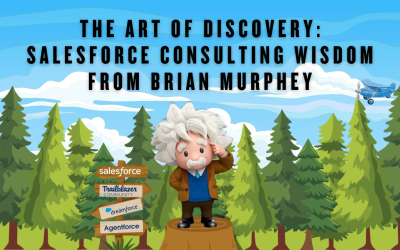Your Salesforce org is probably clogged up with reports that have been created and never run – possibly by users that no longer work for your company, based on metrics you may no longer even measure, or on fields that you no longer capture data for. Creating a Report of Reports lets you quickly scan for reports that can be deleted or archived to really clean up your Salesforce org.
Join Natalie, Head of Operations & Client Delivery, as she shows you how a Report of Salesforce Reports can help you to identify reports that are not active or purposeful so that you can keep your Salesforce analytics clean and ready to use for data-based decision making.
Contact us with your Salesforce challenges at info@cloudadoption.solutions – we love to help!
Cloud Adoption Solutions is a 100% woman-owned registered Salesforce partner, specializing in implementation, integration, and optimization for Technology, Healthcare/ Life Sciences, and Financial Services/ Professional Services organizations in the small and mid-commercial sectors.
VIDEO TRANSCRIPT:
Hi, everyone, this is Natalie with Cloud Adoption Solutions. And today I have a quick tip on how to create a report of reports. The reason for creating this type of report is to keep your org clean, to keep track of who is creating reports, and to build some governance around report creation and the cleansing behind them.
Typically, what happens in an org, a user will create a report and forget about it. Two years later, the admin comes in. Typically, they’re inheriting that org. And they’re taking a look at all the reports that have been created. And seeing that no one is running them, the person who created them no longer works for the company.
So there’s several reasons why you would want to perform this type of cleansing. So what I’m going to do is just show you how to create the report, it’s very simple. I’m clicking on the reports tab, a new report. And this type of report is administrative in nature. So you’ll find it under the administrative report section. So click that. And then click reports. And here, you will see the Report Builder, which will allow you to start compiling the fields related to this report.
So I’m going to bring in a couple of fields that are very important. Create a date is one of them. So you want to see the created date behind the reports that are in your system. Last run date, it’s always a good one, the name of the report, which will be helpful and description, we’ll pull that field into, I’m just going to rearrange my columns to make this look a little nicer when I run it. I’m going to move last run date next to create a date. And I’ll show you why in just a second. Now that I have my columns rearranged, I’m going to click Run.
Okay, so here’s my report of reports. The first thing right off the bat that I noticed is the description is blank on some of these. So some data governance rules that I would put into place in my org is requiring a description when a report is created. That way, anyone who’s using it or uses it 612 months from now understands why the report was built, and its purpose. The next thing I’m going to do is take a look at this last run column. And I’m going to sort by it. And this will give me all of the reports and the run dates. So if the report wasn’t run at all, I’m going to ask myself, okay, do we need this report is the user using it, maybe it was created in error, or maybe the data behind it just isn’t valid. So I’m going to scan through this report and see there’s a lot of reports that have never been run. And compare that to the created date. If you created it in August of 2019, and it was never run, odds are you’re not going to use it.
Typically I tell my clients if a report hasn’t been run in the last 12 to 18 months, you might want to ask yourself if it needs to be deleted or archived. And if you’re afraid of deleting it, I totally get it. So just archive the report, create yourself an archive folder and throw that report in it just in case you’re not ready to, you know, commit to the full delete. So you can see all these run dates are populated here. What I would do at this point is reach out to the person who created the report. Ask them if it’s still valid if it’s still needed, or if they need to make modifications to it. And what I would do just on a government level, I would probably run this report quarterly, if not quarterly, at least twice a year.
You don’t want to let this wait until the end of the year when you know everything else is due when all the other cleansing that you’re performing in your org is taking place. So if you have any questions regarding how to create this report or any of your Salesforce needs, please feel free to reach out to Cloud Adoption Solutions. We are here to help, thanks!




